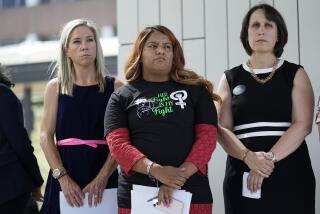A look behind the curtains, not onstage
- Share via
For his latest documentary, “Convention,” filmmaker AJ Schnack wanted to examine the small-scale work that goes into mounting a large-scale event. He chose to focus on the behind-the-scenes stories of the countless people last summer who helped stage the Democratic National Convention in Denver, recruiting a dream team of colleagues from the world of nonfiction cinema to detail the massive effort required to put on the historic event.
The speeches and procedural drama of the convention itself are only glimpsed in the film, which screens in competition tonight at the Los Angeles Film Festival following its world premiere last week at the SilverDocs Film Festival. Instead, the focus is on the more localized efforts of city officials, reporters from the Denver Post and various grass-roots protest groups.
“I’d always thought of what happens on the stage as a touchstone for the audience,” said Schnack, whose previous documentary, “Kurt Cobain: About a Son,” garnered critical acclaim for its lyrical examination of the life of the late Nirvana frontman.
“My crude reference is ‘Back to the Future [Part] II,’ where the excitement is seeing what happened from another angle,” he said. “You’ve already watched the convention on television, now you’re seeing what was happening just off to the side of the camera.”
To gain the kind of access the project required, Schnack turned to his friend, third-generation Denver resident and current interim executive director of the Denver Film Society Britta Erickson, who helped open doors for him.
Erickson, credited as a producer on the documentary, proved an important ally when it came to tracking down possible subjects. She went to school with two of the subjects and a third was a former employee.
--
No time to worry
Schnack and producer Nathan Truesdell flew to Denver about a month before the convention got underway to lay some initial groundwork, returning just a week before the event. By then the buildup was in full swing, and their subjects simply had too much else to do to worry about the sudden presence of video cameras in their daily lives.
“We had a little bit of time for them to adjust to us being there,” Schnack recalled, “but mostly they were so busy they didn’t really have time to pay that much attention to us. It was sort of like, ‘And now we’re going to be with you all the time. Get used to it.’ And they sort of had to.
“I think if we had come in months earlier and said what we wanted to do, everyone would have said no.”
Finding subjects was one thing, finding crews to actually follow them was another. Schnack has plenty of contacts in the documentary community, however -- he operates a widely read documentary blog called “All These Wonderful Things” and co-founded the Cinema Eye Honors documentary awards. The group of people that shot the movie -- Laura Poitras, Paul Taylor, Julia Reichert, Steven Bognar and Daniel Junge, among them -- includes two Oscar nominees.
“When we were coming up to the convention I had a list of around 10 filmmakers, and then literally it was who was available to come at the last moment,” said Schnack. “I think we called Steve and Julia and Laura on Friday before the convention and told them, ‘You have a plane ticket for Monday morning.’ ”
--
Filming on the fly
Once the team was in place in Denver with cameras in hand, Schnack simply had to turn it loose. Maintaining communications was sometimes tricky, as phone service around the convention center could be spotty due to the volume of calls being made in the area. Often the camera crews had to make their own decisions about where to go and whom to follow.
“It was something in theory I liked,” said Schnack of allowing each camera person to use his or her own sensibility to inform what they were shooting. “In practice I liked it even more. . . . You needed people who were actually filmmakers, who could make decisions.”
A title card near the beginning of “Convention” credits 11 people with making the film, and that nod to the optimistic idealism of collective action -- what a group of people working together can achieve -- is the theme both in front of and behind the camera.
Although the film ends with Barack Obama’s speech accepting his party’s nomination, the emotional climax of the movie comes during a speech given by city workers Chantal Unfug and Katherine Archuletta to a group of departing interns. It’s a seemingly small moment that takes on greater significance, as Schnack explained.
“It’s the spirit of the film, both the characters in the film and behind the scenes, the notion of ‘We can do this. Let’s all get together, and together we can make something awesome.’ ”
--
More to Read
Only good movies
Get the Indie Focus newsletter, Mark Olsen's weekly guide to the world of cinema.
You may occasionally receive promotional content from the Los Angeles Times.










